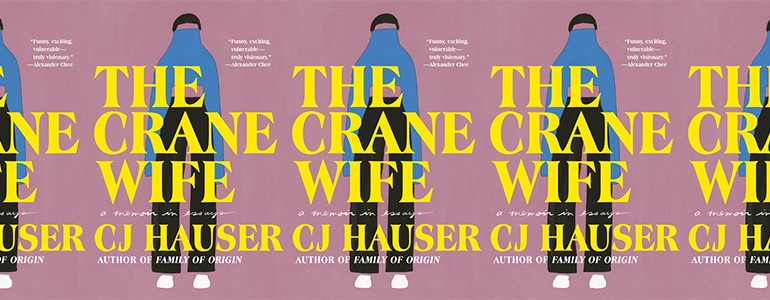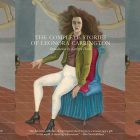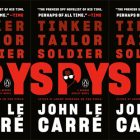The Crane Wife’s Interrogation of the Self

When the Paris Review published CJ Hauser’s personal essay “The Crane Wife” in 2019, it went viral. At the time, Hauser was launching her climate fiction novel Family of Origin, and the essay she set out to write was an off-the-book piece on her field research. Instead, she wrote about how she came to break off her engagement just ten days before leaving on a scientific expedition to study the whooping crane. It became the titular essay of her next book, The Crane Wife.
A memoir-in-essays, The Crane Wife, out today, is what happens when a self-professed theatre kid from a theatre-loving family breaks character to question her performance of romantic love. Calling off her wedding is a dramatic interruption that leads Hauser to pull back the curtain on beloved familial and cultural stories she says she imprinted on as a child—stories that formed her ideas about intimacy and individuation. Hauser’s interrogation of these stories reveals as much about what it means to love someone else as it does about what it means to love a story, and ultimately, this interrogative act leads her inward, as she turns the force of her questioning toward herself and the unexpected shape of her own life story.
In “The Crane Wife,” Hauser alternates between writing of her relationship’s dissolution and of the whooping crane’s struggle for survival in the Gulf Coast. At a wildlife reserve gift shop, Hauser encounters a work of Japanese folklore about a crane who disguises herself in order to marry a man and then spends every night plucking out her feathers to maintain appearances. As Hauser comes to realize that “no one can survive denying their own needs,” the essay becomes a treatise on need—an accounting of the natural resources needed for the whooping crane’s survival and a reckoning with the fact of her own needs. Rather than settle into a marriage that requires self-denial, Hauser must risk disrupting the narrative expectations she held for her own life. “I think I was afraid that if I called off my wedding I was going to ruin myself. That doing it would disfigure the story of my life in some irredeemable way,” she writes. “I had experienced worse things than this, but none threatened my American understanding of a life as much as a called-off wedding did.”
It’s Hauser’s anxieties about the shape of her life story that, in turn, give shape to the narrative arc of her memoir. Written in nonlinear prose, the book’s essays do not proceed chronologically but—perhaps true to form for a theatre-kid turned novelist—are arranged in a spiraling adaptation of the four-act structure.
The wave-like, Aristotelian arc that structures much of Western fiction is a form borrowed from Greek tragedy, a form that some literary critics have mapped onto sexual experience. In the introduction to Meander, Spiral, Explode: Design and Pattern in Narrative (2019), Jane Alison offers a generous critique of the dramatic arc. “There’s power in a wave, its sense of beginning, midpoint, and end; no wonder we fall into it in stories,” she writes. “But something that swells and tautens until climax, then collapses? Bit masculo-sexual, no?” Alison goes on to argue for experimenting with patterns in fiction that better fit other life experiences, other “deep motions in life.” If the dramatic arc imitates a wave, the alternative narrative patterns Alison identifies also imitate nature: spirals, radials, networks and cells, and fractals. By extending Alison’s work in narrative design to creative nonfiction, it becomes possible to identify the alternative narrative patterns at work in The Crane Wife.
Perhaps this memoir-in-essays takes the shape of a spiral. For all that Hauser writes about other subjects—the whooping crane, robot trials, John Belushi’s gravestone—as narrator, she is the central axis around which these essays whirl. Even as Hauser moves forward in time, she keeps circling back to the story of her first love, a story she tells in three separate essays (titled “Act I: The Mechanicals,” “Act II: The Fantasticks,” and “Act III: Dulcinea Quits”). These three acts are written in the second person, as if Hauser is speaking directly to herself. Elsewhere in the book she reflects on this relationship, writing: “Since that first, mythical time I fell in love, I have never trusted a person the same way.”
Or perhaps The Crane Wife takes a radial shape, exploding outward from the central heartbreak of her called off wedding. Perhaps it’s both, or something else altogether. As Hauser grapples with the changing shape of her life story, it’s fitting that the shape of each essay and, indeed, the shape of the collection itself, are self-consciously experimental in form.
Hauser’s essay collection opens with “Blood: Twenty-Seven Love Stories,” which is a collage essay that functions as an origin story—or perhaps it would be better to speak of it plurally, as in origin stories. The essay’s twenty-seven parts are tightly written vignettes that, taken together, show how Hauser’s personal love stories are entwined with family love stories, all of which are imbued with theatricality.
Two chronologies advance in time over the course of the essay to form a two-stranded braid of vignettes. The first begins in 1918, with Hauser’s great-grandfather’s first marriage ending in bloodshed. The second begins in 1984, with Hauser’s first kiss at a baby play group. Many of the stories involve blood: blood-borne sadness, fake blood (a middle-school staging of Macbeth), donated blood, the blood of a quickening pulse. These two romantic histories—one familial, one personal—spiral together to form a sort of double-helix, much like the DNA found in blood. It’s an apt structure, since DNA contains the hereditary information humans need to develop and reproduce. As Hauser sequences the love stories she carries in her blood, she concludes, “It was years of family stories that hid the ways women knew in their blood what was wrong or right. Hid truth behind the scrim of romance, or worse, fate.”
In addition to family stories that impart lessons about love, Hauser turns her attention to stories found on stage, on the screen, and on the page. This bent for cultural criticism is the aspect of The Crane Wife that is, perhaps, most essayistic. Shakespeare’s A Midsummer Night’s Dream, The Philadelphia Story starring Katharine Hepburn, L. Frank Baum’s Oz series, The X-Files, and Shirley Jackson’s novels are just some of the texts Hauser writes about in The Crane Wife. In “Hepburn Qua Hepburn,” Hauser writes that she was thirteen when she “romantically imprinted on the 1940 film adaptation of The Philadelphia Story.” She calls it an “instructive text,” one that she rewinds and rewatches. With each subsequent viewing, she analyzes the film for what it might reveal about the nature of “true love”—a phrase that turns up in several of the book’s essays. Excerpts from the film’s screenplay interrupt Hauser’s reflections, which contributes to the feeling that the path through this essay is one that spirals like a VHS tape, as she rewinds, pauses, then plays on.
Of course, what Hauser sees in the film changes with time. As a teenager, she is taken with how Hepburn’s Tracy must choose between three men, and therefore between three possible selves. What does Tracy’s choice of romantic partner indicate about her tastes? Who does she want to be? What kind of life does she want? One way of summarizing the film, Hauser notes, is that men explain Tracy to Tracy. One way of reading The Crane Wife is to trace Hauser’s attempts to explain herself to herself.
Hauser’s later readings of the film focus on other characters, other questions, including the film’s handling of intimate partner violence. But it’s the film’s lessons about identity and compatibility that chase Hauser into adulthood. Eventually she arrives at this insight: “In hetero relationships my choices and desires always seem to yield more readily than men’s. I’m not confident I won’t bend myself into whatever shape it is the next man requires of me.” As Hauser rewinds and rewatches the film, she learns to see herself anew.
Similarly, in “The Second Mrs. de Winter,” Hauser turns to a novel only to face herself. Just as she discovers that she (unfortunately) shares eerily similar tastes with her boyfriend’s ex-wife, a friend persuades her to read Daphne du Maurier’s Rebecca. Hauser’s reading of the novel reveals her relationship’s fatal flaw: she “felt trapped in a rerun of someone else’s life.” The scene at the heart of the essay is a Valentine’s Day date to the Mirror Maze, an attraction located in a shopping mall called Destiny. Buzzed on a couple of beers, Hauser and her boyfriend become separated in the maze, and she struggles to find her way out. He “was nowhere to be seen and I was multiplied everywhere.” She was lost in a “tunnel of my own reflections.” Eventually she follows his voice out of the maze. But, by the essay’s end, it’s a turn inward that shows her the way out of the relationship, a turning toward herself, the woman “in whose reflection, somewhere, was an opening.”
In facing herself, Hauser doesn’t just rewind films and reread novels, she also revisits scenes from her past. The third act of The Crane Wife opens with “Nights We Didn’t,” an essay about Time Travel. Time Travel is a game Hauser plays with her regrets, moments she wishes she could return to for a do-over. This essay centers on one moment in particular, her relationship with Maggie, or rather the relationship that almost was. Hauser falls for Maggie while dating Sam, and though she gets together with Maggie, the guilt over breaking up with Sam eventually leads her to break up with Maggie, and in the end, they all end up hurt (in spectacularly dramatic theatre-kid fashion). Hauser writes, “These days I say ‘bisexual,’ I say ‘pansexual…These days I say queer, but in college? I said nothing.” Seeking to take ownership of the pain she caused and make amends, Hauser writes her apologies to Maggie and Sam into the essay. But this story keeps her “blocked,” and she keeps returning to it in Time Travel. Years later, she shares this story with several women she becomes close to at a writing residency. She confesses to other moments of regret, early encounters that ultimately went nowhere. A writer-friend tenderly reframes these as “queer beginnings.” Hauser concludes, “The first time you felt a way. The first time you tried to be the way you felt. These are stories, too. These nights you didn’t. You’re allowed to call them beginnings.” In giving herself and her readers permission to own the shape of their stories, Hauser demonstrates the liberatory potential of disrupting conventional narrative patterns.
Throughout The Crane Wife, Hauser breaks the fourth wall to engage in metacommentary about the stories she’s crafting and to call into question her authorial choices. In the memoir’s fourth act, her direct address to the reader takes on more intensity. All this is evidence of Hauser becoming a “first-person person.” In an earlier essay, after passing out in a first-person VR simulation, Hauser reflects, “I was forced into the one role I had relentlessly trained myself to avoid…What does it feel like to be me? I had no idea.” Over the course of the book, Hauser’s narration shifts as she accepts her own subjectivity, what she calls “the role of myself.”
The book’s penultimate essay, “Uncoupling,” is about Hauser’s relationship to her body, specifically her breasts, as she considers breast reduction surgery. It’s also about accompanying a friend to fertility treatments, which occasions Hauser’s own reflections on the possibility of parenthood. She concludes the essay in refusal. She refuses to jump forward in time to tell the reader of her decisions, or even of whether her friend becomes pregnant. She refuses to bring the narrative threads together and insists that keeping them separate is the point.
And then, she speaks directly to her readers and challenges their desire for narrative resolution. She writes, “If you are feeling unsatisfied…ask yourself: Who told you these things went together? What stories were you told, and not told, about the shape of love, the shape of yourself, the shape of a happy life?”
Reading The Crane Wife is a bit like following Hauser into the Mirror Maze, her voice as narrator guiding the way through and out. Whether writing about familial or cultural stories, each text becomes a mirror in which Hauser sees herself reflected back. And in her willingness to turn inward, to truly face herself, Hauser’s essays open outward, becoming themselves mirrors into which readers might gaze.



